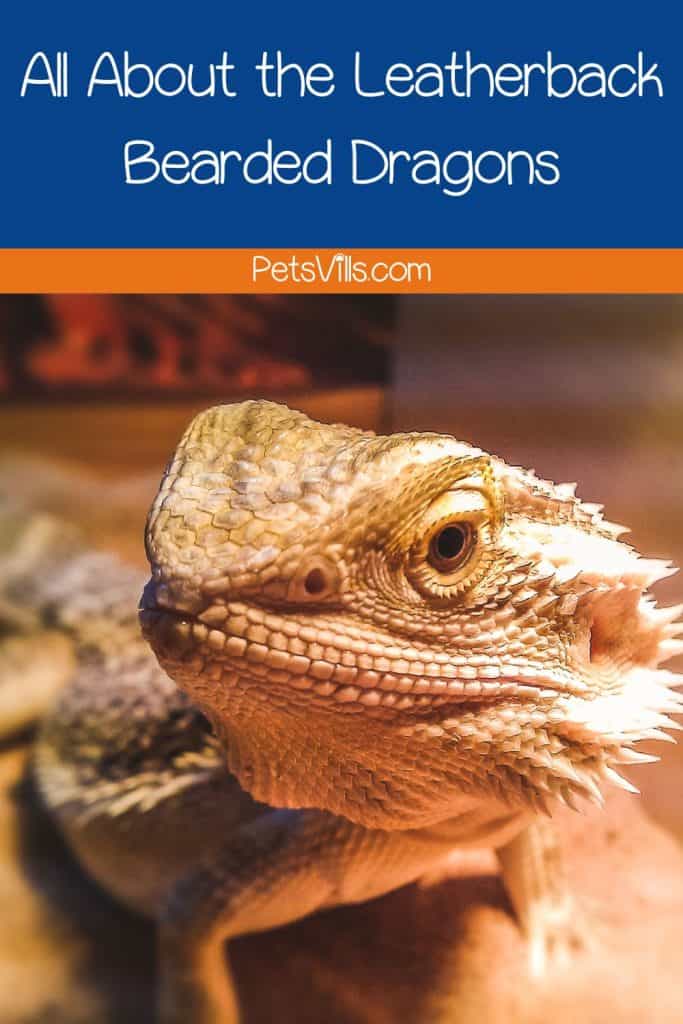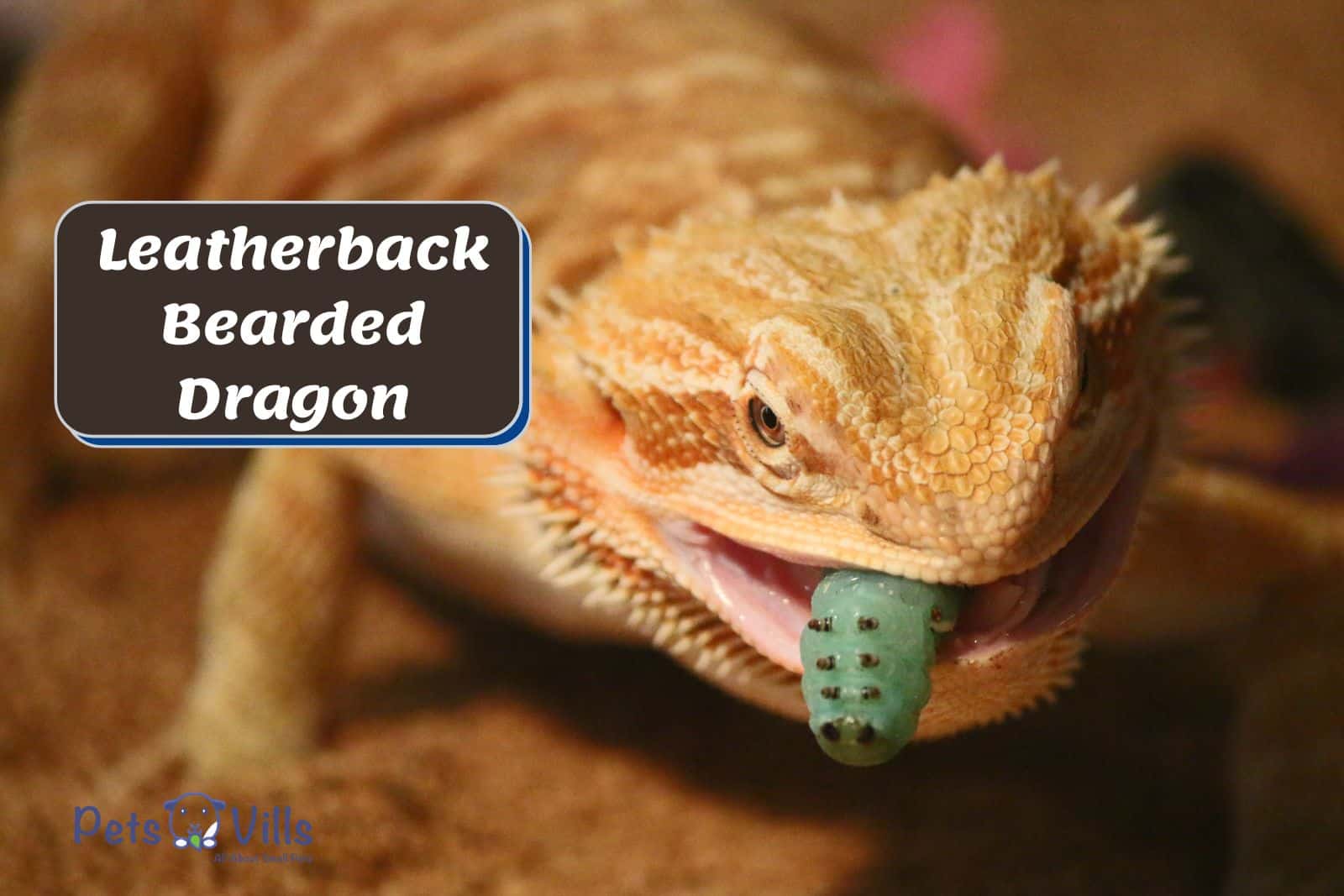Are you trying to figure out, “What are leatherback bearded dragons?”
A couple of years ago, I saw a leatherback bearded lizard at a reptile expo, and I was so smitten with its appearance I wanted to have one.
So, I talked with several experienced breeders and did tons of research to figure out if this type of bearded dragon was the right one for me.
And today, I’m going to share my experience with you!
Table of Contents
Quick Summary
- Leatherback bearded dragons are one of the most popular morphs, thanks to their unique smooth scale texture.
- Leatherback lizards are healthy animals, and they have the same tank and diet requirements as common beardies.
- They make excellent pets but are more expensive than regular bearded lizards.
Leatherback Bearded Dragons: History, Appearance, and Facts
I used to think all pet bearded lizards looked the same – tan/brown with spikes along their backs and the typical “beard” below the chin.
However, several bearded dragon morphs have appeared through selective breedings. These reptiles differ in colors, scales, and patterns.
Leatherback lizards are one of these unique morphs, and their stunning looks make them highly sought-after pets.
Before talking more about the appearance of these reptiles, I’ve got some interesting history to share.
History
Genetic mutations occur all the time in the wild. However, a wild Pogona Vitticeps lizard with vibrant colors is easy prey for predators, so it doesn’t survive for long.
Fortunately, such mutations also appear in captive dragons. When breeders can reproduce the odd appearance or bright color, they call it a genetic morph (a gene-related trait).
All leatherback bearded dragon morphs are bred in captivity. The dominant/recessive gene responsible for their appearance causes reduced scalation, interfering with scale formation.
One of the first occurrences of the co-dominant leatherback gene mutation was in Italy. Then it quickly gained enough popularity to spread to other countries.
The Italian and American leatherback dragons are almost identical in appearance. However, Italian leatherbacks carry the dominant gene, while American leatherbacks have the recessive gene.
You won’t be able to tell the two apart by the naked eye. And it only matters if you’re getting a leatherback breeding pair to produce silkback dragons.
And what do leatherback bearded dragons look like? Let’s find out!
Appearance
Leatherback bearded dragons are easily recognizable with their triangular heads, smooth backs, and vivid coloration.
The mutated leatherback gene affects the scale size and scale texture, resulting in small, smooth scales and no spikes on the back.
Leatherback lizards also come in a variety of colors, such as red, yellow, citrus, blue, and other color combinations. And the lack of spikes makes their normal skin color appear vivid and vibrant.
Interestingly, some breeders use the word “smoothie” to describe leatherback lizards. But don’t confuse leatherbacks with silkbacks.
Silkbacks don’t have any spikes or scales, while the leatherback morphs still have scales along the back and the usual spikes on the head and sides.
Size and Weight
The usual Pogona Vitticeps measures 16 to 24 inches from head to tail and weighs 10 to 20 oz (~300 to 600 grams).
Leatherback dragons have a similar size and weight. However, the German Giant bearded morph(the biggest bearded dragon in the world) can reach up to 30 inches in length and can be a leatherback.
Lifespan
Despite breeding in captivity, leatherback bearded dragons are healthy animals. They live 10-12 years on average, but some can live longer with proper care and a balanced diet.
Usually, premature death results from improper tank temperature/humidity or poor diet, lacking sufficient calcium.
Health Issues
The Leatherback morph is prone to the same common diseases that affect normal beardies, such as:
- Metabolic bone disease. It’s due to calcium and vitamin D3 deficiency, causing bone and muscle damage.
- Parasites, such as pinworms, ticks, and mites.
- Respiratory infections
- Mouth rot – a bacterial infection of the gums, resulting in swelling and thick mucus discharge.
- Viral diseases, such as atadenovirus. You can’t cure ADV-positive bearded dragons, but you can alleviate their symptoms and slow down complications, such as liver disease.
According to a study published in the Journal of Experimental Biology:
The scales on the skin of normal bearded dragons were reducing the amount of water that they lost, potentially protecting them from dehydration. (1)
So, leatherback bearded dragons have a higher risk of dehydration than normal lizards. You have to pay attention to their hydration levels.
Fortunately, the majority of health issues bearded dragon owners face can be resolved with a proper bearded dragon diet and tank adjustments. More about how to care for leatherbacks in a bit!
Leatherback Bearded Dragon Diet
The leatherback morph’s diet is identical to the diet of the common beardie. Adults need plenty of leafy greens, fruits, and flowers (around 80%) and not so many insects (around 20%).
On the other hand, baby leatherback beardies should eat more insects than plants because they require more protein to support their growth.
And now let’s talk about how how to recognize leatherback bearded dragons.
Common Bearded Dragons Vs. Leatherback Bearded Dragon: How to Tell Them Apart?
Leatherback bearded lizards are similar to common beardies and silkback lizards, so it’s natural for you to have trouble telling them apart. But a few genetic traits can help you tell them apart!
Check this comparison table for a quick look at the difference between these bearded lizard morphs! Or watch this video.
| Normal Beardie | Leatherback Bearded Dragon Morph | Silkback Bearded Dragons | |
| Size | 16-24 inches | 16-24 inches (The German Giant morph can be 30 inches from head to tail.) | 16-24 inches |
| Color Types | Tan or brown is the normal color | Lighter colors, such as orange, red, citrus, etc. | Vivid colors |
| Scale Texture | Scales cover the entire body, rough in texture | Small scales, fine and smooth in texture | Smooth skin, no scales |
| Spikes | Yes | No dull spikes along the back | No spikes |
| Behavior | Easy-going | Easy-going | Easy-going |
| Special care | No | Can become dehydrated quickly | No scales to protect the skin from extreme heat |
Color
Common Australian dragons have a darker color, usually tan or brown, allowing them to camouflage in the desert.
Leatherback lizards have vivid colors, such as red, orange, and citrus. etc. But some bearded lizards don’t retain their color into adulthood – they get darker or lighter as they age.
Scale Texture
As I already mentioned, leatherback bearded dragons have smooth scales. Common beardies’ skin and scale are rough.
If the bearded dragon has no scales or spikes, it’s not a leatherback lizard but a silkback one.
Scale Size
The leatherback’s genetic mutation interferes with scale formation, so these dragons have small scales.
Spikes
Bearded Australian dragons have spikes along their backs. But leatherback lizards lack these spikes.
Special Care
Leatherback bearded dragons have the same needs as common beardies. But the reduced scalation makes “smooth” lizards prone to dehydration. You’ll need to watch your beardie’s hydration levels.
And now, let’s talk in detail about how to care for these amazing reptiles!
How to Care for a Leatherback Bearded Dragon
Captive adult or baby bearded dragons are easy to care for, as long as you keep a few things in mind to ensure proper calcium absorption and prevent common diseases.
Tank Size
The right enclosure is one of the most important aspects of caring for leatherback bearded dragons.
According to the reptile experts from VCA, “the length of the cage should be at least 2 times their total length.” In most cases, a 75-gallon tank is enough. (2)
The tank should have at least two hiding places, a basking spot, decorations (rocks, branches, etc.), and a water bowl (bearded lizards do drink water).
Don’t keep several beardies in one tank. I made that mistake once, leading to displays of aggression and fights for territories. Bearded lizards are solitary animals and don’t need much company.
You should clean the vivarium once a month to maintain proper hygiene. And be careful because bearded dragons carry Salmonella – wash your hands well.
And now, let’s talk about how to keep the vivarium as close to the dragon natural habitat as possible.
Light/Heat
It’s vital to choose a light bulb with high ultraviolet light output. Improper lighting can interfere with calcium absorption and contribute to metabolic bone disease and other health problems.
You need a UVB light that can maintain 12 hours of daylight. And you should change the UV bulb every six months because its output decreases with time.
Moreover, lizards can’t regulate their body temperature because they’re cold-blooded animals. They need an external heat source to keep warm.
Your leatherback beardies require a basking spot with a temperature of 95-105°F (35-40 degrees Celsius), an ambient temperature of 75-85°F (24-29°C), and a cool side of 80°F.
At night, the temperature can go as low as 70°F. Check this article for tips on how to manage lightning at night.
Inadequate heat can cause respiratory issues and skin problems. Purchase a thermometer for proper heat management.
Humidity
According to the RSPCA’s care sheet, humidity should be between 30% to 40%. High humidity can cause respiratory problems, bacteria/fungus overgrowth, and other health problems. (3)
Low humidity is also dangerous for bearded dragons because it can interfere with the shedding.
Substrate
Ceramic tiles, newspapers, or paper towels are one of the best substrates for leatherback bearded dragons. Avoid sand and wood shaving since they can cause impaction.
Feeding
I feed baby leatherback lizards insects (around 80% of their diet) and safe vegetables, such as collard greens, mustard greens, spring greens, etc.
Adults need plenty of leafy greens, fruits, flowers, and a little bit of animal protein. Popular insects for bearded lizards include earthworms, silkworms, and crickets.
Insect size also matters. Larger insects are suitable for adult dragons, while small ones are for babies and juveniles.
And you need to sprinkle the leafy greens with calcium and vitamin D3 supplements. Low levels of calcium can cause weakness, lethargy, and constipation, among a few.
Shedding, Brumation, and Breeding
All bearded lizards shed because their scales can’t stretch to accommodate their growing bodies. Babies and juveniles shed every couple of weeks, while adults – a few times a year.
Leatherback bearded dragons also brumate – slowing their body functions and metabolism to survive cold temperatures. It’s similar to hibernation. So, don’t panic if your lizard seems lethargic or doesn’t eat a lot.
Still, if your animal has problems with shedding or you’re not sure it’s brumating, you should seek a vet.
As for breeding, adult females can lay their eggs as early as nine-months-old. But most experts recommend waiting until your lizard is at least 2-3-years old.
Also Read: Things To Know About Red Morph Bearded Dragon Care
But are leatherback bearded dragons good pets, and where can you buy them? Let’s find out!
Are Leatherback Bearded Lizards Good Pets?
“Smooth” bearded dragons have the same behavior as any regular beardie – they’re docile, don’t mind interacting with humans, and rarely exhibit extreme behavior, such as aggression.
They’re great pets for novice reptile owners and can get along well with children. And bearded lizards enjoy petting as long as you do it right.
Still, each dragon has an individual personality. Some are shy, others are social, and a few exhibit dominance behavior.
To encourage bonding, I always give my bearded lizard treats when picking it up and never try to play with it when it’s not in the mood.
Where to Buy Leatherback Bearded Dragons?
You can find leatherback dragons for sale in many pet stores, online reptile shops, or through breeders’ websites.
Reptile expos also have plenty of rare dragons for sale, and you can get plenty of tips on proper care and husbandry by visiting one. But how much do these unique animals cost?
How Much Do Leatherback Bearded Dragons Cost?
The coast of bearded dragons depends on the specific mutation, color combinations, and age. You can expect to pay around $100-$500 for a leatherback.
Other rare lizards, such as Witblits dragons or Paradox dragons, cost $800-$1000.
Also Read: What is a Fancy Bearded Dragon?
FAQs
1. What Is the Difference Between a Leatherback And a Regular Bearded Dragon?
A leatherback morph has small, smooth scales and no spikes along the back. Its color is also more vivid than a regular beardie’s color.
2. What Is the Rarest Bearded Dragon?
Albino dragons, Paradox dragons, and zero-bearded lizards are one of the rarest bearded dragon morphs. Dragons with bands of coloror blue color are also not common.
3. What Is the Cheapest Bearded Dragon?
In the pet trade, the common beardie (Pogona vitticeps) is the cheapest bearded dragon species, costing around $20.
4. Can You Breed Two Leatherback Bearded Dragons?
Yes, you can. Breeding two leatherbacks will produce a silkback – a lizard with no scales and spikes. But some vets consider silkback a genetic defect because they can’t lead a normal life.
5. How Do I Know What Morph My Bearded Dragon Is?
To recognize bearded dragon morphs, you should look at their physical traits. For example, the translucent morph has see-through skin/spikes, while the paradox morph has random patches of color.
Conclusion
Leatherback bearded dragons are among the most popular morphs, thanks to their smooth scale texture and friendly temperament. They’re easy to care for and make excellent pets, even for children.
To ensure you get a healthy bearded dragon, always inspect the entire body for signs of injuries and missing body parts. And don’t forget about maintaining proper heat, light, and humidity.

What do you think about leatherback bearded dragons? Have you ever seen one? Share your thoughts in the comments.
Resources:
1. Knight K. Scales save bearded dragons from dehydration. Journal of Experimental Biology. 2021;224.
2. Bearded Dragons – Housing [Internet]. vca_corporate. Available from: https://vcahospitals.com/know-your-pet/bearded-dragons-housing
3. Bearded dragon CARE SHEET ENVIRONMENT [Internet]. Available from: https://www.rspca.org.uk/documents/1494939/0/Bearded+Dragon+Care+Sheet+%28PDF+350KB%29.pdf/151bb6df-1c35-a484-6de8-bffed4985abf?version=1.0&t=1556100899951&download=true
Grigorina grew up surrounded by animals – dogs, cats, cows, goats, sheep, and horses and that has shaped her into what I am today – a crazy cat lady who always has a place for one more cat (or a dog). She has two female cats – Kitty and Roni, and two tomcats – Blacky and Shaggy, but she also feeds her neighbors’ cats when they come for a visit. I just can’t say no to them. Follow her on FACEBOOK AND INSTAGRAM
Read her latest articles HERE
Learn more about her


